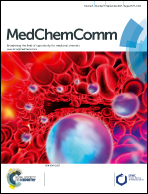C5-substituted pyrido[2,3-d]pyrimidin-7-ones as highly specific kinase inhibitors targeting the clinical resistance-related EGFRT790M mutant†
Abstract
The development of specific kinase inhibitors has been a long-standing challenge in chemical biology and drug discovery. We have successfully discovered a series of C5-substituted pyrido[2,3-d]pyrimidin-7-ones as highly specific inhibitors against the clinical resistance-related EGFRT790M mutant. One of the most promising compounds, 9f, tightly binds to the EGFRT790M mutant and strongly inhibits its enzymatic function with an IC50 value of 0.80 nM, and displays an extraordinary target specificity with S(35) and S(10) selectivity scores of 0.005 and 0.000, respectively, in a kinase selectivity profiling study against 456 different kinases at 100 nM. The compound also selectively suppresses the proliferation of EGFRT790M mutated H1975 NSCLC cells with an IC50 value of 2.80 nM, but is significantly less toxic to cells with wild-type EGFR. Compound 9f may serve as a promising lead compound for drug discovery overcoming the acquired resistance of NSCLC patients without adverse toxicities.
![Graphical abstract: C5-substituted pyrido[2,3-d]pyrimidin-7-ones as highly specific kinase inhibitors targeting the clinical resistance-related EGFRT790M mutant](/en/Image/Get?imageInfo.ImageType=GA&imageInfo.ImageIdentifier.ManuscriptID=C5MD00208G&imageInfo.ImageIdentifier.Year=2015)

 Please wait while we load your content...
Please wait while we load your content...